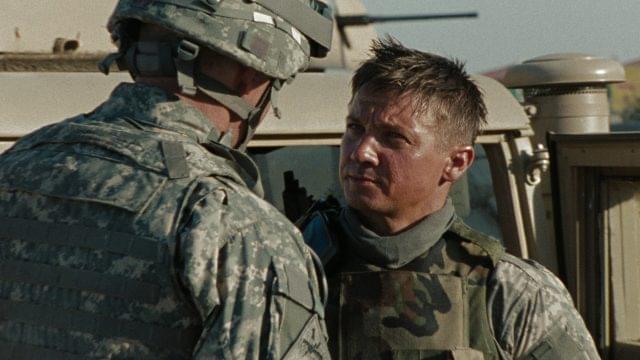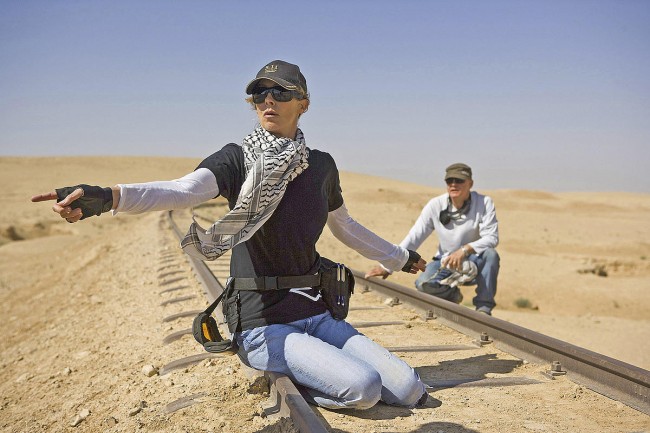Kathryn Bigelow
33. The Hurt Locker, directed by
Kathryn Bigelow
Blowing Shit Up With Homemade Dynamite
By Rose Marel
The thing about bombs is that they’re always unexpected. Even in colloquial terms, to “drop a bomb” is to reveal a huge piece of juicy, unforseen news. But even having foresight proves to be ineffective against the shock of a detonation. No matter how aware you are of their presence, upon explosion, the instantaneousness of a bomb is an irreversible shock. You could expect a bang but be met with none, or you could expect a bang but be gone before it manifests. Or you could wrongly not expect one at all, which is possibly a better scenario for the same outcome.
As part of an Army Explosive Ordnance Disposal unit, it’s James’ job (played by a macho Jeremy Renner) to get up close and personal with each and every discovered bomb. By James’ count, he’s up to 873 personally dismantled bombs. That’s 873 palpitating moments of mental preparation, 873 instances of anxious anticipations where life and death are separated by the clip of a wire. It’s 873 successes, but also 873 meetings with failure. Because here, for James to be unsuccessful is for him to be obliterated in that nano-second before recognising his failure. Thus, the suspense leading up to this moment is all the more heightened. The Hurt Locker chronicles the countdown of days left in the unit’s rotation, which dwindle in tandem with the accumulation of bombs dismantled.
We see bomb after bomb, discovery after discovery, fate or skill being tested on what could even be an hourly basis. If death resided beneath a layer of ice, James would be skating all over it. Is it unfair to test death so constantly? Does life keep a tally and can you run out of chances? These questions haunt James’ Iraq rotation, a landscape that amounts to a crop of bombs planted by who even knows. It could be the man you’ve been watching or it could be the one who’s watching you. It’s a battlefield that’s equally as psychological as it is literal. Not knowing who your enemies are – and allowing us to feel this – draws attention to the amoral conflict of modern warfare. Being aware of potential threats can easily feed into paranoia, and even inherently non-confrontational soldiers can turn harsh and jumpy with the surrounding possibilities. This same jumpiness is translated through a jerky camera style, which constantly disrupts itself with cutaways. Jolting between multiple angles is almost like a jitterish person obsessively glancing over their shoulders, and we accordingly gain a sense of the danger and their hyper awareness of it. In remaining consistent with this handheld, frenetic filming approach, The Hurt Locker places us directly into the action to emotionally unite us with the day-to-day experiences of the soldiers.
Being aware of potential threats can easily feed into paranoia, and even inherently non-confrontational soldiers can turn harsh and jumpy with the surrounding possibilities. This same jumpiness is translated through a jerky camera style, which constantly disrupts itself with cutaways. Jolting between multiple angles is almost like a jitterish person obsessively glancing over their shoulders, and we accordingly gain a sense of the danger and their hyper awareness of it. In remaining consistent with this handheld, frenetic filming approach, The Hurt Locker places us directly into the action to emotionally unite us with the day-to-day experiences of the soldiers.
Bigelow proves herself to be an expert in delivering exhilarating action that percolates with serious tension. This movie is tense as fuck. There’s rarely a moment of release from it and, even if there is, it’s not for long, because snipers are armed and bombs are waiting. At times, it even feels close to a mockumentary. The only thing potentially undermining the hyper real, doco-style filming is the unbelievable portrayal of bomb detonation. Succumbing to the typical Hollywood obsession of hailing a central ‘hero’ figure, James is excessively glorified in his bad boy portrayal. He’s held up as a quasi-genius in his field, evidenced by his survival. Yet James also rips his communication device out, ignores his superior’s orders, repeatedly puts his team in danger and often handles specific devices with a rough carelessness.

Operating within a world heavily reliant on teamwork, James’ recklessness is supposedly a selfish act of mutual benefit. If it works out, he’ll save them all. More than that, his wildness could be intended as a subconscious craving for life. By nonchalantly testing the edge of his mortality, he remains mentally rooted within it, keeping himself from slipping into a place of shock. Does it come across as such? For me, developing this no-fucks-given character, which I assume is meant to be appealing to audiences (“He’s so cool”) essentially weakens the integrity of the real-life war experiences.
That said, there’s no glamorization of war here. Visually cloaked in dirt and decay, we’re in no way seduced by ideas of romanticism. The horizon wavers with heat, the air clouds with dust and children are treated like animals, or adults, or simply pawns in a grotesque and senseless game. Committing to her stylistic rawness reinforces Bigelow’s overall approach to truth, and zeros in on the pervading mission: personal survival.